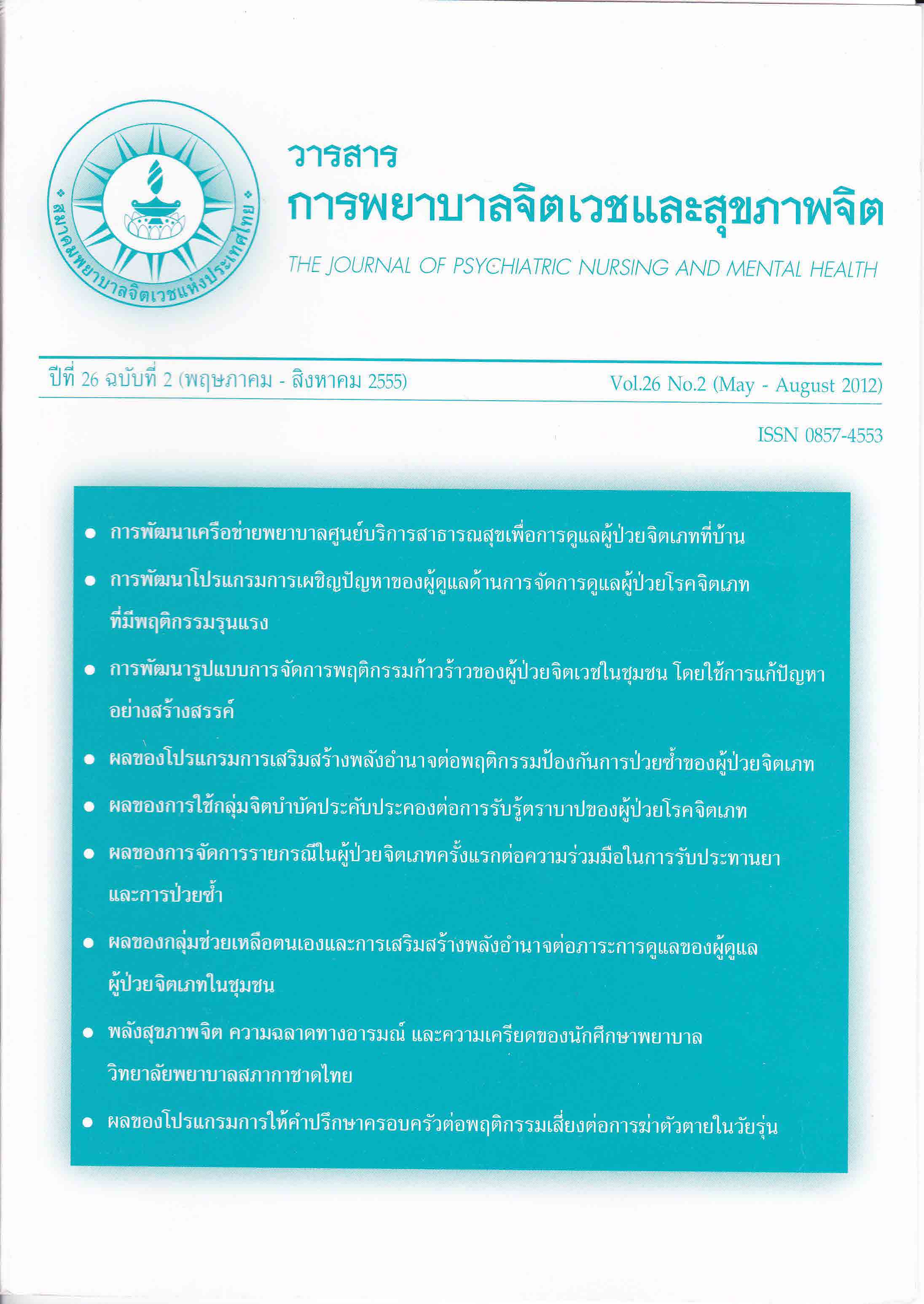ผลของการใช้กลุ่มจิตบำบัดประคับประคองต่อการรับรู้ตราบาปของผู้ป่วยโรคจิตเภท
Main Article Content
บทคัดย่อ
บทคัดย่อ
การวิจัยกึ่งทดลองครั้งนี้ มีวัตถุประสงค์เพื่อเปรียบเทียบการรับรู้ตราบาปของผู้ป่วยจิตเภทก่อนและหลังได้รับการบำบัดด้วยกลุ่มจิตบำบัดประคับประคอง และเปรียบเทียบการรับรู้ตราบาประหว่างกลุ่มที่ได้รับการบำบัดด้วยกลุ่มจิตบำบัดประคับประคองกับกลุ่มที่ได้รับการพยาบาลตามปกติ กลุ่มตัวอย่าง คือ ผู้ป่วยจิตเภทจำนวน 40 คน ซึ่งคัดเลือกเป็น 2 กลุ่ม คือ กลุ่มทดลองและกลุ่มควบคุม ด้วยการจับคู่ตามอาการทางลบและเพศ ได้กลุ่มตัวอย่างกลุ่มละ 20 คน กลุ่มทดลองได้รับบำบัดแบบกลุ่มที่ผู้วิจัยสร้างขึ้น ส่วนกลุ่มควบคุมได้รับการดูแลตามปกติ เครื่องมือที่ใช้ในการวิจัย คือ 1) โปรแกรมกลุ่มจิตบำบัดประคับประคอง 2) แบบประเมินการรับรู้ตราบาป 3) แบบประเมินการปรับตัวทางสังคม ซึ่งตรวจสอบความตรงตามเนื้อหาโดยผู้ทรงคุณวุฒิจำนวน 5 ท่านเครื่องมือชุดที่ 2 และ 3 มีค่าความเที่ยง CronbachAlpha เท่ากับ .93 และ .81 วิเคราะห์ข้อมูลโดยใช้สถิติทดสอบที (t-test)
ผลการวิจัยสรุปได้ดังนี้
1. การรับรู้ตราบาปผู้ป่วยจิตเภทหลังได้รับการบำบัดด้วยกลุ่มจิตบำบัดประคับประคองต่ำกว่าก่อนเข้าร่วมกลุ่มอย่างมีนัยสำคัญทางสถิติที่ระดับ .05
2. การรับรู้ตราบาปผู้ป่วยจิตเภทหลังการทดลองของกลุ่มที่ได้รับการบำบัดด้วยกลุ่มจิตบำบัดประคับประคอง ต่ำกว่ากลุ่มที่ได้รับการพยาบาลตามปกติอย่างมีนัยสำคัญทางสถิติที่ระดับ .05
คำสำคัญ : ผู้ป่วยจิตเภท, การรับรู้ตราบาป, กลุ่มจิตบำบัดประคับประคอง
Abstract
The purpose of this quasi-experimental research were: 1) to compare the stigma of schizophrenic patients before receive and after received the group supportive psychotherapy, and 2) to compare the stigma of schizophrenic patients who received group supportive psychotherapy and those who received regular caring activities. Forty of schizophrenic patients receiving services in outpatient department, Ratchaburi Central Hospital, who met the inclusion criteria, were matched pair and then randomly assigned to experimental group and control group, 20 subjects in each group. The research instruments consisted of : 1) The group supportive psychotherapy program, 2) The Internalized Stigma of Mental Health scale, and 3) The social adjustment Scale. All instruments were validated for content validity by 5 professional experts. The reliability of the 2 and 3 instruments were reported by Chronbach’s Alpha coefficient of .93 and .81. The t-test was used in data analysis.
Major findings were as follows:
1. The stigma of schizophrenic patients who received the group supportive psychotherapy was significantly lower than those before (p < .05).
2. The stigma of schizophrenic patients who received the group supportive psychotherapy was significantly lower than those who received regular caring activities (p < .05).
Keywords : Schizophrenic patients, stigma, groupsupportive psychotherapy
Article Details
บทความที่ได้รับการตีพิมพ์แล้ว เป็นลิขสิทธิ์ของสมาคมพยาบาลจิตเวชแห่งประเทศไทย


